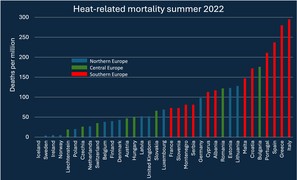Reduced heat exposure and mortality by limiting global warming to 1.5 °C

Photo: The 2003 heat event led to an excess of 15,000 deaths in France, of which 735 in Paris.
The Paris Agreement makes a distinction between 1.5 °C and 2 °C global warming (above pre-industrial conditions). Warming should be limited to 2 °C global warming, but a limit at 1.5 °C is strongly preferred to avoid severe impacts of climate change. A recent study shows that the proportion of the population exposed to hot summers above the current record increases dramatically from 1.5 °C to 2 °C global warming.
This study looked at the population exposure to heat extremes in summers in Europe in the period 1950-2017. With this reference in mind, they quantified the exposure of the European population to historically unprecedented heat extremes in a 1.5 °C and 2 °C warmer world. Clearly, unprecedented hot summers are more likely in a 2 °C world than in a 1.5 °C world. In parts of southern and eastern Europe the difference in likelihood is a factor two.
Strong increase exposure
In the current climate in Europe, on average more than 45 million people are exposed to temperatures above the observed record during the summer. This number would increase to 90 million people in a 1.5 °C warmer world, and to 163 million people in a 2 °C warmer world. These numbers refer to 11% (1.5 °C) and 20% (2 °C) of the continent’s population, respectively.
The chance of having a summer with such widespread heat that at least 400 million people (or almost 50% of the continental population) experience a summer temperature exceeding the historical record is negligible in the current climate. In contrast, in a 1.5 °C warmer world such an event would occur on average once in 18 years, and in a 2 °C world once every seven years.
Strong increase mortality
In another study, the likelihood of a heat-mortality event similar to the one of 2003 was estimated in a 1.5 °C and 2 °C warmer world for the cities of London and Paris. According to this study, stabilizing global warming at 1.5 °C rather than 2 °C would make a 2003 heat-mortality event 2.4 times less likely in London, and 1.6 times less likely in Paris.
Sources:
- King et al., 2018. Nature Climate Change 8: 549-551.
- Mitchell et al., 2018. Nature Climate Change 8: 551-553.






